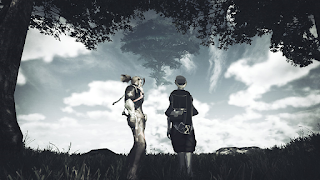Torna: The Golden Country Review: A Moment of Eternity
Set in the world of Alrest 500 years before the events of Xenoblade Chronicles 2, the story follows the Torna mercenary Lora and her blades Jin and Haze as they attempt to hunt down Malos, an especially powerful blade (called an Aegis) bent on destroying the world.
The expansion assumes the player is already familiar with Xenoblade Chronicles 2 and Alrest's lore, because it expands on characters and events only alluded to in the main game. So you'll already know the fates of everyone going in, but it's more about the journey than the destination, and its a good one. Torn's story is much more constrained than the base game, focusing largely on the relationship between all of the cast members and setting up the plot threads that won't fully pay off until Xenoblade Chronicles 2.
Torna takes place exclusively on two titans: the new titan Torna and the returning titan Gormott. Gormott gives returning players a chance to glimpse the changes that have taken place over the last 500 years, and Torna acts as an entirely new, fresh area to explore. I loved the new protagonist Lora far more than Rex. She is mature, compassionate, and charismatic. There are a lot of heartfelt moments between her and characters that will later become friends and enemies, which only added to the tragedy of her tale, knowing the events that will inevitably unfold.
A new community mechanic has the player recruit NPCs by talking to them or by doing side quests. At two particular points in the main story-line the Community level will need to be raised to two and four respectively, in order for the main plot to progress. None of the side quests are especially interesting, but several featured recurring characters and multi-part story-lines that helped to further flesh out the main cast. The Community mechanic is sorta arbitrary; it was included to force the player into engaging and connecting with the inhabitants of Alrest; an attempt to form attachments and makes Torna's fate all the more tragic. It's an unfortunate necessity, but shouldn't be an issue for those who enjoy side quests.
"Blades" are anthropomorphised weapons in humanoid or animal form, as well as special companions that are bonded to a single person - called a "Driver". The party is made up of three Drivers utilizing two Blades each: Lora (Jin/Haze), Addam (Mythra/Minoth) and Hugo (Brighid/Aegaeon). Just like in Xenoblade Chronicles 2, Drivers auto-attack as soon as they are close enough to an enemy. Auto-attacks gradually fill four diamond shaped icons - three of which are for special actions called "Arts". Arts are triggered manually by the player and will result in either a direct attack, defensive move or healing spell, depending upon which Art is used. Most Arts come with a secondary condition that can spawn a healing item or topple an enemy. The fourth icon is for a "Special Attack". Specials come in four levels and are a bit like Arts, but more involved. They require the player to engage in quick time events and will deal more damage than the Driver's other attacks.
Unlike with Xenoblade Chronicles 2's battle system, a Driver and both of their Blades simultaneously participant in combat. Torna encourages players to switch between the Driver and their two Blades as the situation warrants, making use of the entire team's unique skills. "Blade Combo"s are back in a new three-step elemental chain instead of the chart used in the base game. The change was likley due to the fixed party setup in Torna, so every elemental chain works, but only a few are special combos.
The methods for upgrading party members is the same as the base game: a mixture of experience, accessories, and affinity goals. Inns have been replaced by campsites scattered around the wilderness. They are where the group meets to talk, sleep and craft - a new addition that makes use of a Blade's interests to create items. A Blade's skills are still used to unlock treasure chests hidden around the world or to gain extra items from collection points like in the base game, but are a lot less restrictive.
Torna masterfully sets the stage for the events that will unfold in the base game by building on the lore from the XB2 and even enhancing it. The prequel adds much needed clarity and emotional weight to some of the more enigmatic scenes from Xenoblade Chronicles 2, particularly those involving Lora and her blades. It's just a shame that the time we get to spend with Lora, Jin, and Haze is so short in comparison to Rex and his gang.
Related Reviews:





















Comments
Post a Comment